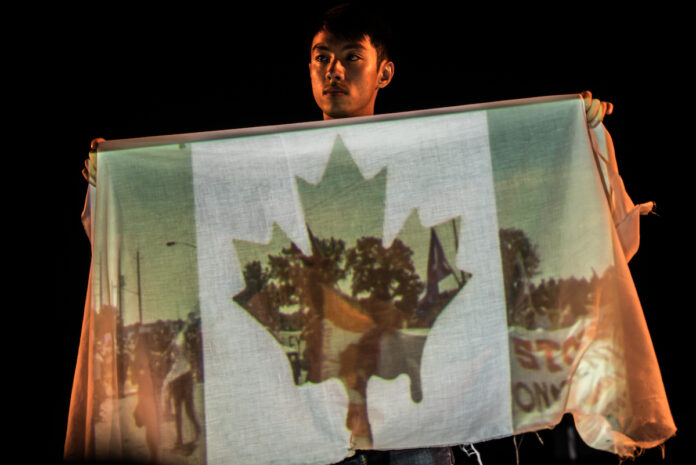
Performing as the only cast member on a compact stage with limited lighting, props and a projector is a tall order for most theatre folks. In The Chemical Valley Project, produced by the Great Canadian Theatre Company (GCTC) in partnership with the Broadleaf Theatre, the one-man cast and talented production team used these daunting circumstances to their advantage to create an unconventional yet masterful performance.
Co-created by Kevin Matthew Wong and Julia Howman, the documentary-play tells the true story of the Aamjiwnaang First Nation in Sarnia, Ont. The small community—nicknamed “Chemical Valley”—suffers silently as their homes become entrapped by chemical plants, pipelines and toxic pollution. After hearing chilling statistics of pollution levels in Chemical Valley, Wong heads to Sarnia to hear the perspective of the Aamjiwnaang people.
The play follows Wong, the sole performer, along his journey as he recounts meeting Indigenous activists Vanessa and Beze Grey. As the two offer a unique outlook on inequitable treaties, climate control and reconciliation, Wong takes on the role of an active listener, documenting and projecting the stories and mindsets brought forth by the most important yet unheard voices.
As the lights dimmed, Wong transformed himself, showing versatility as he took on many roles throughout the performance. He was the omniscient tour guide dissecting Indigenous and environmental issues for the audience. He was the fly-on-the-wall documentary creator, talking with Indigenous peoples to better understand Chemical Valley. He was also the comic, cracking jokes and interacting with the audience in the show’s more lighthearted moments.
Wong led by example in the way he approached the controversial topics discussed within the play. He allowed Vanessa and Beze’s perspectives and concerns to speak for themselves, even though they were not present onstage. He cleverly incorporated their pictures and interviews into the projections on the screen, bringing significance and art to their narratives.
Though Wong played each role to its fullness, the constant switching of titles was at times confusing and quick transitions made it hard for audience members to invest themselves in the emotional journey. In one moment Wong would flash heartbreaking pollution statistics onto the projected screen, only to be followed by a comical impression of Shakespearean actors. Although each impression was spot-on, the frequent shifts in tone made it hard to fully engage with the performance.
Where the performance may have stumbled with its occasionally awkward storytelling, the technical theatre stole the show. The set design was intentionally very simple, consisting of a desk with a lamp and a few props. The rawness of the design meant every element was used to its full extent: A toy car sitting at the edge of the desk wasn’t just some meaningless knick-knack, but rather something Wong used to represent his journey around Sarnia. A moving landscape was projected behind the car, giving it the appearance of motion.
The lighting, designed by John Cabanela, and the sound design, from Wong and Frank Incer, added another layer to an already spectacular performance. Wong utilized the spatial audio and moody light within the intimate theatre setting to add crucial emphasis to the performance. He also stood poetically in line with the flickering projector as fire breathed on the backdrop, leaving the audience engulfed in his narrative as the sound of crackling flames and orange glares seeped in from all directions.
The Chemical Valley Project tackled complex issues using a very simple approach. Through sadness and laughter, Wong highlighted the importance of listening to the perspectives of Indigenous communities. In a sickening era where human rights are treated as politics, Wong reminded audiences that the best medicine is to listen.
Featured image by Dahlia Katz.





